The iOS AppStore in 2013
On March 28th 2013, after several months of development we launched Shopster, our groceries list app. On this post I’d like to cover what we did in anticipation to the launch, how it correlated to sales, and a glimpse n our future plans. I think it paints a good picture of the state of the iOS AppStore in 2013.
About Shopster
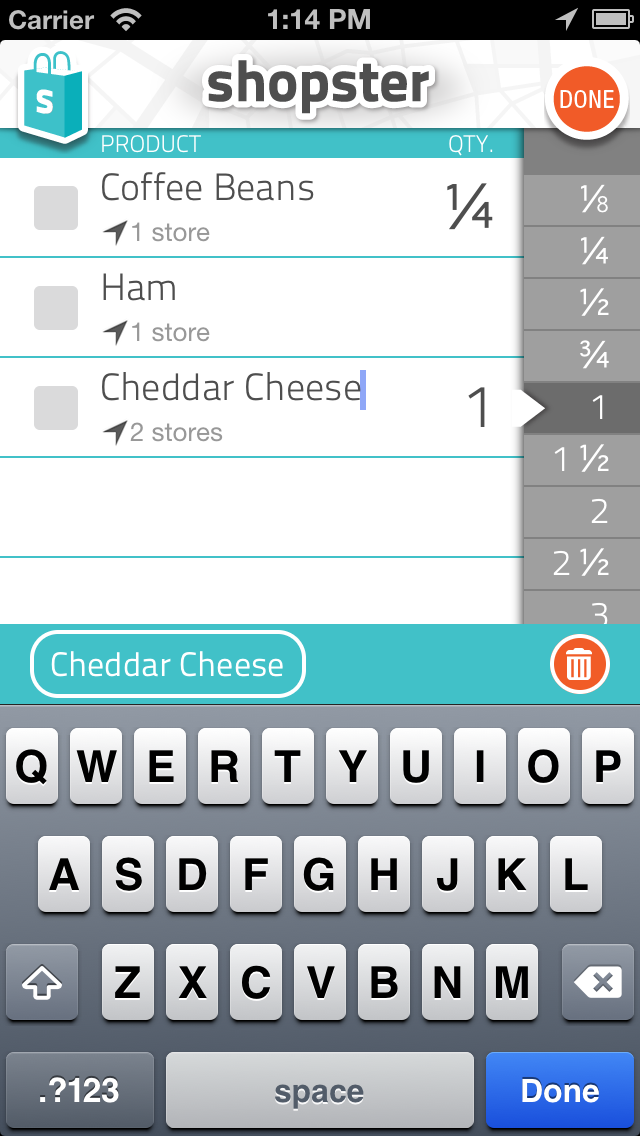
In case you don’t know it, here’s what Shopster looks like. It’s a simple groceries list app with a twist: it automatically learns the location where you check an item as purchased, so it can later use that information to trigger a location geo-fenced reminder.
Pre-launch
We submitted the app to Apple with time to spare, and set a release date well in advance. This gives you time to pitch your app to tech writers for reviews while having promo codes available, as well as some cushion time should you need to submit an urgent fix (we did, and it was great to see it approved before launch).
We started pitching well known blogs based on our preferences and by checking their reviews of competing apps. For each blog we tried to find -when possible- the specific person to write to, instead of just sending a generic email.
We also booked an ad with The Syndicate for the week after our launch. We see this ad as kind of a meta ad: their network covers sites that are followed not only by our target audience, which is very broad, but also by lots of other bloggers who review apps. My thinking here was that it could help us boost awareness of the app and have more reviews.
Launch day
The launch date arrived, and the app showed up in the App Stores. It was a national holiday Argentina, so I was out of the office playing with my kids, while frantically checking email and reloading RSS feeds and Twitter looking for mentions of our app.
On launch date the app was mentioned or reviewed by The Loop, GigaOm and TUAW. Our road to fame and
money had begun, or so we thought until the next morning.
First week of sales
I can’t say the first day sales were a disappointment, as I was not sure what to expect, since our previous apps did not have the coverage Shopster had. We were surprised to see the app had only sold about 200 units. Here’s a graphic of our sales (in units) throughout the first week in the AppStore:
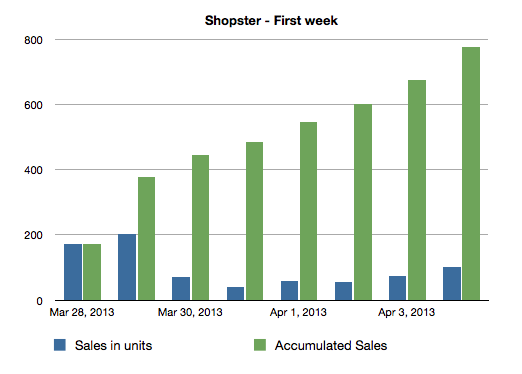
What’s interesting to me here is to see how these sales correlate with the AppStore rankings. Rankings are believed to be the best available marketing tool, as they give your app great visibility, but the calculations Apple use to generate those are unknown.
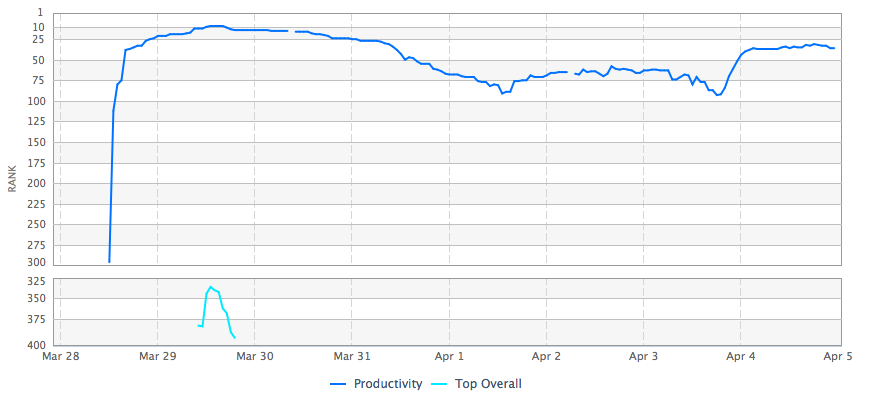
As you can see, in our first week averaging 100 sales a day, our app ranked consistently in the top 100 productivity apps.
Interesntingly1, the Top Grossing rank paints a different story:
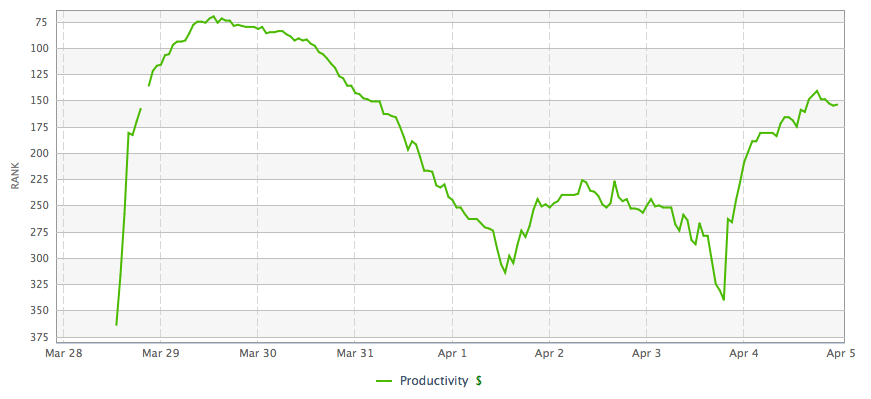
As you can see, Shopster only ranked as high as 75th and remained in the Top 300 (contrast that with being in the Top 100 for Top Paid).
First Month
Dring the first month of life of the app, we continued too gain awareness of the app. Shopster got reviewed by Gizmodo and finally, on April 11th, it was picked by Apple as New and Noteworthy. At the point we thought sales would skyrocket. Our app even got mentioned by AppStore’s Twitter account:
Make grocery shopping easier. Shopster sends alerts when you’re near stores where you’ve previously purchased items. tw.appstore.com/yvt
— App Store(@AppStore) April 17, 2013
Here’s a summary of the sales during the first four weeks:
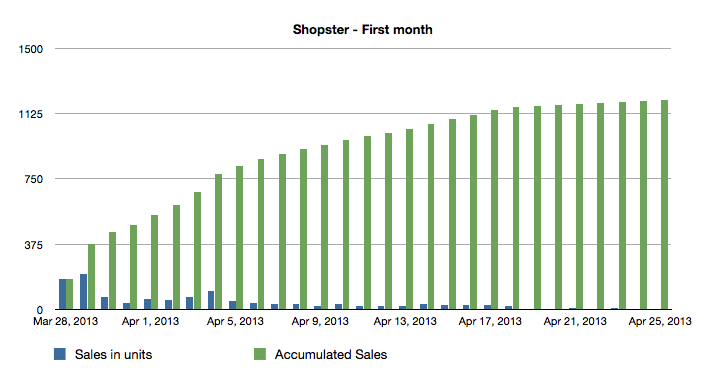
As you can see, things did not get better, and our app averaged 41 sales per day.
Analysis
It’s still hard for me to understand what makes an app a hit and what makes it fail, so I’ll share my current hypothesis of some things that may have happened with Shopster:
- We downplayed the ability to share lists. We knew it was important and the competition had it, but we decided to leave it out of 1.0. In retrospect it was probably a mistake.
- Geo-fencing is probably only useful for a subset of potential customers. Our marquee feature, having the app learn the locations where you buy stuff, is probably most useful for metropolitan users that commute to work and walk a little. For these users, the feature can prove a life saver. For the rest, is probably not that important.
- Users invested in other apps may not be eager to switch. It’s hard to convince a loyal customer unless its using a clearly worse alternative. If he’s using one of our better competitors, they probably have invested a lot of time and effort into making these apps suite their needs and won’t look for alternatives. This is a clear contrast to more technical users, where we are more eager to test alternatives for the sake of finding that perfect app.
- We priced the app too low. Some competing apps are USD 2.99 and rank in similar positions as Shopster. Had we price it USD 2.99 instead, we could have at least made more profit to reinvest in new features. Pricing low is a mistake we won’t make again. You can always lower the price, even temporarily, but making it higher is more problematic.
The Future
I’d like to close this post with our view for both the future of Shopster and the AppStore business.
For Shopster we are working on a major update that will bring the highly requested feature of sharing lists. We have some great ideas on how we can make that experience unique to the user, and think we can get a “second round” of awareness of our App and convince more users to try it.
We’ll also probably try a higher price, as our sharing features will bring some fixed monthly costs we need to cover for.
We are not ready to give up on Shopster, so at the very least we want to give it a second chance.
As for the future of Quadion in the AppStore, we’ll try to make more sustainable businesses. We now think apps need to be able to offer some subscription based pro features, so your best customers can commit to annual or monthly payments that help pay the bills. I think the best model is what Instapaper or Pinboard offer, where they have an upfront payment that gives you most of the basic features, and a sustainable subscription model with more advanced features.